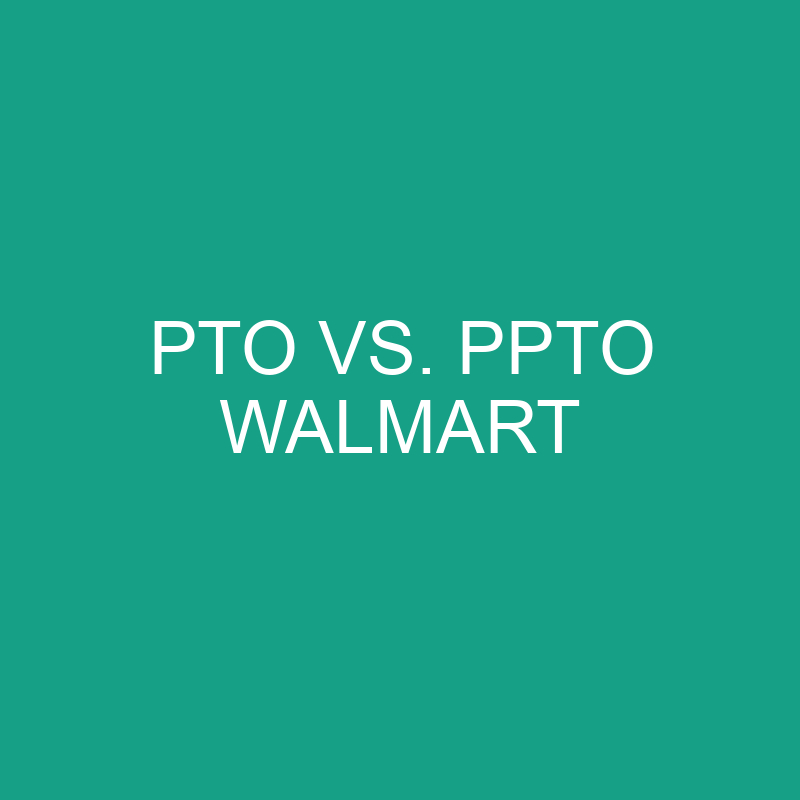Navigating Time Off: PTO vs. PPTO in Walmart’s Leave Policies
Time off policies in the workplace are essential components of an employee’s benefits package. They provide the necessary flexibility for individuals to balance work and personal life. In the context of Walmart, two acronyms frequently surface in discussions about leave policies: PTO (Paid Time Off) and PPTO (Protected Paid Time Off). This article aims to dissect the distinctions between PTO and PPTO within Walmart’s leave policies, shedding light on their definitions, applications, and the considerations employees should be mindful of when navigating their time off.
Post Contents
1. Understanding PTO (Paid Time Off)
Definition:
Paid Time Off, commonly known as PTO, refers to a policy where employees accrue a certain number of hours or days that they can take off while still receiving their regular pay. PTO is a versatile system that encompasses various types of leave, including vacation days, personal days, and sometimes even sick days.
Accrual:
The accrual of PTO varies based on company policies and the tenure of the employee. Generally, employees earn a certain number of PTO hours for every hour worked or per pay period.
Usage:
Employees can use PTO for a variety of reasons, including vacation, personal business, or when they are under the weather. The flexibility of PTO allows individuals to manage their time away from work according to their needs.
Considerations:
While PTO offers flexibility, its usage may be subject to approval by the employer. Additionally, some companies have policies regarding the maximum accumulation of PTO hours, incentivizing employees to take time off regularly.
2. Decoding PPTO (Protected Paid Time Off) at Walmart
Definition:
Protected Paid Time Off, or PPTO, is a specific category within Walmart’s leave policies. It is designed to provide employees with protected time off with pay for certain qualifying events or situations.
Qualifying Events:
PPTO at Walmart is often associated with situations where an employee is unable to work due to illness or injury. It may also be applicable in cases of bereavement or other personal emergencies.
Usage:
Employees at Walmart can use PPTO when they need to take time off due to qualifying events. It provides a layer of protection by ensuring that the employee receives pay for the time off, even if they are unable to work.
Accrual:
Similar to PTO, PPTO accrues over time, and the rate of accrual can depend on factors such as the employee’s tenure with the company.
Considerations:
The term “protected” in PPTO signifies that the time off is safeguarded with pay. This provides financial security for employees facing challenging circumstances that require them to be away from work.
Comparative Analysis: PTO vs. PPTO
1. Scope:
- PTO: Encompasses various types of leave, including vacation, personal, and sometimes sick leave.
- PPTO: Specifically designed for protected time off in qualifying situations like illness, injury, or bereavement.
2. Flexibility:
- PTO: Offers broad flexibility for employees to use their accrued hours for various reasons.
- PPTO: More focused on specific situations, providing protection in times of need.
3. Approval Process:
- PTO: Usage may be subject to approval by the employer but is generally more flexible.
- PPTO: Often associated with situations where approval is likely to be granted due to the nature of the qualifying events.
4. Accrual Rate:
- PTO: Accrual rate can vary and is often influenced by factors like tenure.
- PPTO: Similar to PTO, accrual rate may depend on factors like tenure and is specifically designed for protected situations.
5. Usage Scenarios:
- PTO: Can be used for a wide range of situations, including planned vacations and personal days.
- PPTO: Primarily intended for situations requiring protected time off, such as illness or bereavement.
**1. Understanding Policies:
- Employees should familiarize themselves with Walmart’s specific policies regarding PTO and PPTO. This includes understanding accrual rates, maximum accumulation limits, and qualifying events for PPTO.
2. Communication:
- Open communication with supervisors is crucial when planning time off. This ensures that the appropriate policies are followed, and approval is obtained in advance when necessary.
3. Balancing Usage:
- Employees should strike a balance in the usage of their accrued time off. Regularly taking time off for rest and relaxation is essential, but awareness of maximum accrual limits is also important.
4. Knowing Qualifying Events:
- Understanding the qualifying events for PPTO is vital. In situations where protected time off is needed, employees should be aware of how to apply for and utilize PPTO.
5. Planning for Unforeseen Circumstances:
- PPTO becomes particularly relevant in unforeseen circumstances like illness or family emergencies. Knowing how to access and use PPTO can provide peace of mind during challenging times.
Conclusion: Empowering Employees with Time Off Options
In the dynamic landscape of the modern workplace, time off policies play a pivotal role in fostering a healthy work-life balance. Walmart’s incorporation of both PTO and PPTO reflects a commitment to providing employees with flexibility while also ensuring that they are supported during challenging circumstances.
As employees navigate the complexities of time off policies, a nuanced understanding of PTO and PPTO empowers them to make informed decisions about when and how to take time off. Whether planning a well-deserved vacation using accrued PTO or relying on the protection of PPTO during unforeseen challenges, employees can find a balance that aligns with their needs and the policies set forth by the company. Ultimately, a well-managed and comprehensive time off policy contributes to a workplace culture that values the well-being and individual circumstances of its employees.
